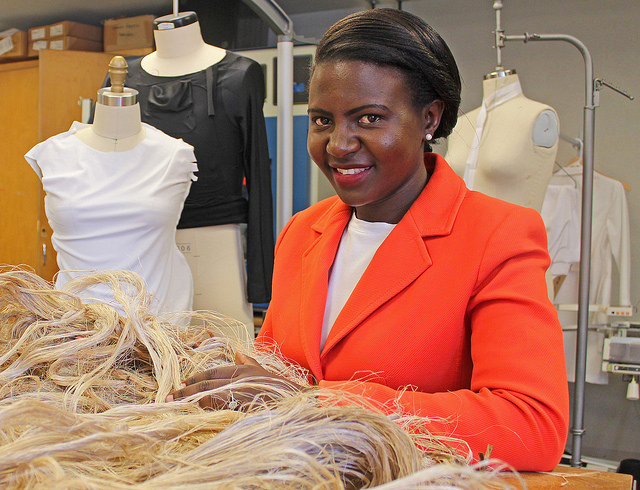OSU student’s idea for banana fabric could be boom for her homeland
Wednesday, September 13, 2017

When Joyce Nabisaalu taught at Kyambogo University in Uganda and saw her colleague making paper from banana stems, she thought, “Why not more?”
Nabisaalu, now an apparel design and production doctoral student at Oklahoma State University, has taken her idea to the next level by researching how to turn banana fibers into fabric.
“He’d cut them into small pieces and then blend them into a pulp and create new papers,” Nabisaalu said. “So I told him, ‘Why not make fabric?’ Since my background is in textiles, I thought, ‘OK. I think I can pursue this.’”
Nabisaalu first came to OSU in 2014 on a professional fellowship program through the U.S. Department of State, but she had no idea this was where she would pursue a new passion.
“At that point, all I knew was that I was coming here to better my teaching and fashion skills,” Nabisaalu said.
After receiving her doctorate, Nabisaalu hopes to teach at a university again and help other people learn how to transform banana fibers into fabric. In Uganda, she had a business teaching young, single mothers how to make clothing for a living.
“In every way, I want to continue supporting them whenever I can,” Nabisaalu said. “I also encourage them to train someone else, better someone else’s life.”
The program that initially brought her to OSU was designed for entrepreneurs in East and South Africa, including Nabisaalu’s hometown of Luwero, Uganda. During the six-week fellowship, she was placed under the mentorship of Dr. Mary Ruppert-Stroescu, a former associate professor of apparel design and textile science in the College of Human Sciences.
“At every step of the way, from the time I very first met Joyce, I was very impressed by her professionalism and her ability to take an idea and develop it and make it her own and think of all the critical, problem-solving ways to look at it,” Ruppert-Stroescu said.
She visited Nabisaalu in Uganda after the fellowship ended and immediately saw the potential in the banana stem project.
With funds from the RIATA Center for Entrepreneurship, Ruppert-Stroescu took on the role of adviser and brought Nabisaalu back to OSU to pursue a doctoral degree and further her interest in clothing made from banana fibers.
“Turning fiber into fabric instead of paper may seem like a little idea at first,” Rupport-Stroescu said. “Then you realize that it has the potential to completely transform the economic and aesthetic landscape for a country.”
In Uganda, agriculture employs 75 percent of the population, with bananas and plantains being the most popular crop. More than 10 million tons of bananas are harvested each year.
With so many farmers growing bananas and discarding the rest of the plant, the materials to make the fibers would otherwise rot and be of no use.
“The clothes you find in America, if they are sold in Uganda, are really expensive,” Nabisaalu said. “A dress here could be like someone’s salary in Uganda. No one can afford it. So, some people prefer the secondhand clothes from Western countries. However, since merchants realized there was a demand for secondhand clothes, they are also now highly priced in Uganda.”
Ugandan cotton production has been in a steep decline due to the high cost of cotton harvesting and labor, so there is more of a market for natural fibers now than ever.
“So, if we have a fiber that can do basically the same thing (as cotton), why not increase our average household income?” Nabisaalu said.
The banana fibers make the clothing completely sustainable and biodegradable, something Nabisaalu and Ruppert-Stroescu agree is a large part of why it will be successful. The softening, finishing and dyeing products are also natural.
Ruppert-Stroescu said she hopes that work on the project will continue to be successful and help the economic and environmental aspects of life in Uganda.
“I don’t think it’s pie in the sky,” Ruppert-Stroescu said. “It’s a big project, but I don’t think it’s impossible.”
Nabisaalu will spend the 2017-2018 school year researching the properties and physical structures of banana fibers. After defending her dissertation proposal in May 2018, she will spend the rest of her time as a student learning how to turn theory to practice and banana stems to clothes.
“I am just so proud of her and so excited for the future of this project,” Ruppert-Stroescu said. “I have all the confidence in the world that she’s going to be able to do great things with this.”
Watch Nabisaalu’s OSU Graduate College Three Minute Thesis presentation on her study of making fabric from banana fibers: http://ra.okstate.edu/STW_Grad/3MC/2017/Nabisaalu/video.html
Story by Aubrie Bowlan
